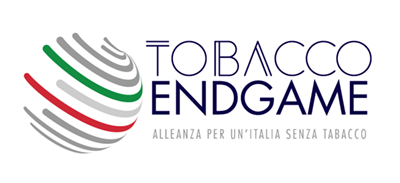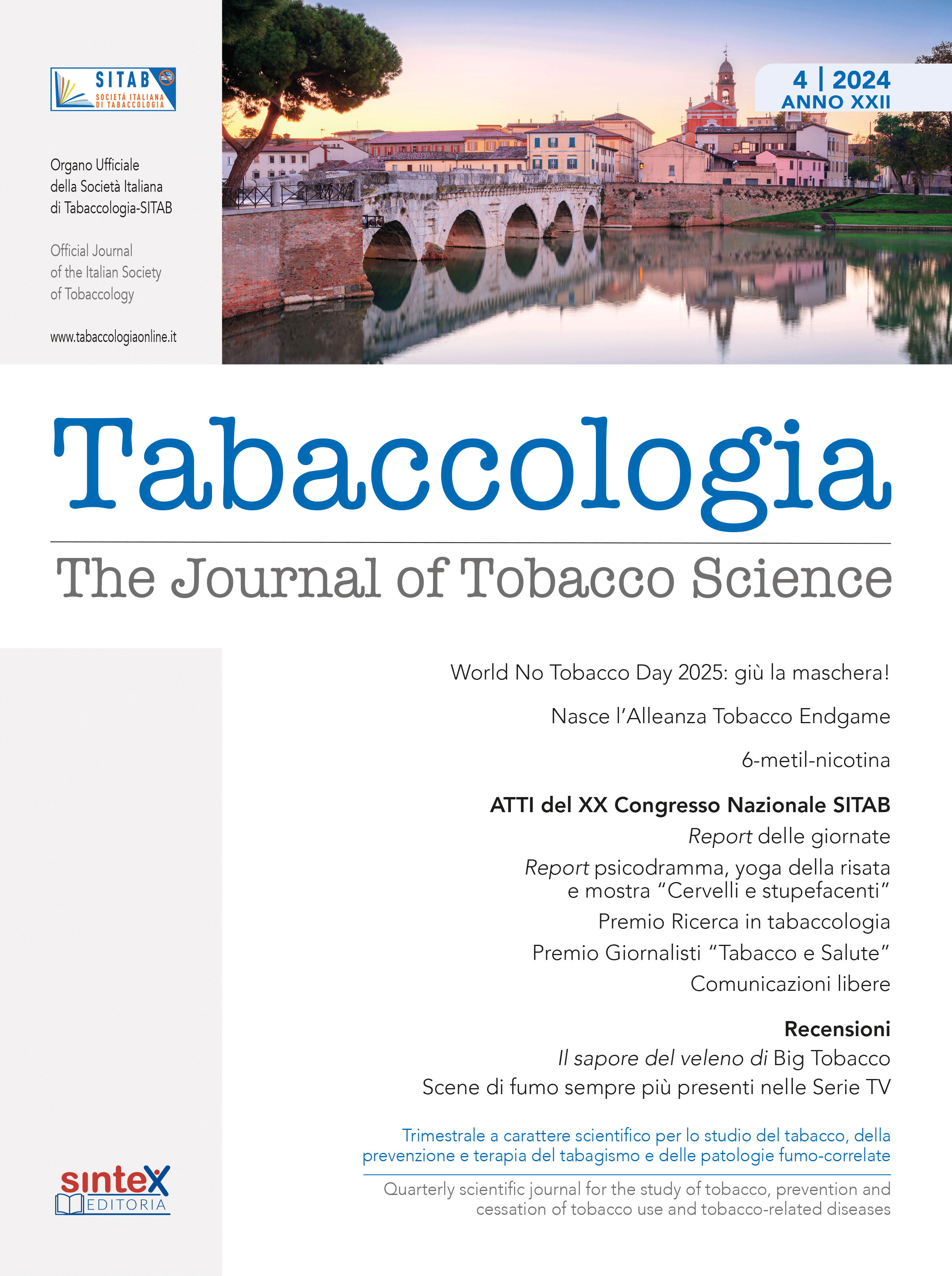|
Rassegna Stampa Scientifica Marzo 2022
|
Thirty years: mourning, celebration and what remains to be done
Tobacco Control 2022;31:121-122.
Online issue publication March 03, 2022
Ruth E Malone
https://tobaccocontrol.bmj.com/content/31/2/121
https://tobaccocontrol.bmj.com/content/tobaccocontrol/31/2/121.full.pdf
Note: Open Access. The 30th Anniversary issue of the journal Tobacco Control (V.31:2) features reports newly available online and all are Open Access. A collection of cartoons I assembled on smoking and health issues and the tobacco industry appears here and, if no technical gremlins have removed it, the Casablanca-themed secondhand smoke cartoon should appear at the top of this bulletin.
"We criticise the companies and their spokespeople—but the key decision-makers escape largely unnoticed and unscathed. It is surely time to bring tobacco company board members more directly into the public arena, and confront them with the personal responsibility they share and bear for millions of deaths… [S]hining a light on the companies’ boards will help identify the true vectors; it will cause well-earned discomfort for the people whose decisions cause so much harm; it will counter the tobacco industry’s new charm offensives; and it will provide yet further rationale for young people and others to steer clear of this evil industry’s products."
Exposing the vectors
Tobacco Control 2022;31:383.
Online issue publication March 03, 2022
Mike Daube
https://tobaccocontrol.bmj.com/content/31/2/383
https://tobaccocontrol.bmj.com/content/tobaccocontrol/31/2/383.full.pdf
Note: Open Access.
"The 2019 WHO [World Health Organization] report on the global tobacco epidemic reported that only 14% of the world’s population live in countries with sufficiently high tobacco taxes. Simple tax structure and frequent above-inflation increases in specific excise taxes are crucial tobacco control measures for any jurisdiction and need to be pursued without delay. Price caps are not a panacea that all countries could readily adopt, but their potential for significant impact suggests they could be an option for countries that already have high tobacco taxes and which are looking to do more."
Where to next for countries with high tobacco taxes? The potential for greater control of tobacco pricing through licensing regulation
Tobacco Control 2022;31:235-240.
Online issue publication March 03, 2022
Michelle Scollo, J Robert Branston
https://tobaccocontrol.bmj.com/content/31/2/235
https://tobaccocontrol.bmj.com/content/tobaccocontrol/31/2/235.full.pdf
Note: Open Access.
Related coverage & PR:
Introduce price cap on cigarettes to reduce smoking – study
Introduce price cap on cigarettes to reduce smoking, new study finds
https://medicalxpress.com/news/2022-03-price-cap-cigarettes.html
'"The tobacco industry is once again infiltrating scientific spaces and presenting a direct threat to the vital work of unbiased tobacco control scientists. With the popular introduction of e-cigarettes and other new nicotine products, the tobacco industry has remade itself into a self-proclaimed concerned corporate entity—and one that will go to great lengths to prop up their new products while opposing credible scientific findings… By appropriating the language of harm reduction, the tobacco industry cynically claims to care about users’ health. But an industry whose financial success depends on the continuous generation of profits will never be in a position to authentically support the elimination of the disease and death caused by tobacco."
The Tobacco Industry’s Renewed Assault on Science: A Call for a United Public Health Response
American Journal of Public Health (AJPH) March 2022
Published Online: February 23, 2022
Jodie Briggs, and Donna Vallone
https://ajph.aphapublications.org/doi/full/10.2105/AJPH.2021.306683
https://ajph.aphapublications.org/doi/epdf/10.2105/AJPH.2021.306683
Note: Open Access.
"For smokeless tobacco and oral nicotine products, higher pH may enhance nicotine satisfaction, but also increase abuse liability, particularly for youth. For e-cigarettes, lower pH and higher nicotine concentrations may mean less exposure to thermally generated toxicants and benefit smokers who want to switch, but may enhance abuse liability among youth… A regulatory challenge to the FDA [Food & Drug Administration] is balancing the potential of non-combusted tobacco products to promote the tobacco endgame in adult cigarette smokers vs. possible harm to youth. Essential in such regulation is a consideration of the impact of pH on the clinical pharmacology of nicotine in various tobacco products."
The Central Role of pH in the Clinical Pharmacology of Nicotine: Implications for Abuse Liability, Cigarette Harm Reduction and FDA Regulation
Clin Pharmacol Ther. 2022 Feb 27. Online ahead of print.
Neal L Benowitz
https://ascpt.onlinelibrary.wiley.com/doi/full/10.1002/cpt.2555
"Most participants preferred capsule cigarettes (single capsule=47.5%; double capsule=12.9%). Flavor capsule users reported that their preferred varieties mostly tasted like menthol/mint (59% of single capsule users and 23% of double capsule users), cucumber (12% and 27%, respectively) or berries (10% and 22%, respectively)… Conclusions: The high prevalence of capsule use and widespread perceptions of the benefits of capsules over traditional cigarettes may help explain why tobacco control policies have not reduced smoking prevalence in Mexico."
Why smoke flavor capsule cigarettes? Preferences and perceptions among adult smokers in Mexico
Nicotine Tob Res. 2022 Mar 4;ntac057. Online ahead of print.
Adebusola Ogunnaike, Katia Gallegos Carrillo, Inti Barrientos-Gutierrez, Edna Arillo Santillán, Yoo Jin Cho, James F Thrasher
https://academic.oup.com/ntr/advance-article-abstract/doi/10.1093/ntr/ntac057/6542427
"The prevalence of prediabetes among current E-cigarette, sole E-cigarette users, and dual users was 9.0% (95% CI=8.6, 9.4), 5.9% (95% CI=5.3, 6.5), and 10.2% (95% CI=9.8, 10.7), respectively. In the fully adjusted model, the ORs for prediabetes were 1.22 (95% CI=1.10, 1.37) for current E-cigarette users and 1.12 (95% CI=1.05, 1.19) for former E-cigarette users compared with that of never E-cigarette users… Conclusions: In this representative sample of U.S. adults, E-cigarette use was associated with greater odds of prediabetes. The results were consistent in sole E-cigarette users."
The Association Between E-Cigarette Use and Prediabetes: Results From the Behavioral Risk Factor Surveillance System, 2016–2018
American Journal of Preventive Medicine
Published: March 02, 2022
Zhenyu Zhang, Zhihua Jiao, Michael J. Blaha, Albert Osei, Venkataramana Sidhaye, Jr Murugappan Ramanathan, Shyam Biswal
https://www.ajpmonline.org/article/S0749-3797(22)00024-1/fulltext
Related coverage & PR:
Diabetes warning over e-cigarettes: Vaping devices could raise risk of high blood sugar, scientists say
Evidence links e-cigarette use with increased odds of prediabetes
https://www.sciencedaily.com/releases/2022/03/220303095636.htm
"Craving was more substantially reduced by smoking r-cigs [regular tobacco cigarettes] than by vaping e-cigs [e-cigarettes]. The response time (RT) for the 3-back task was significantly shorter following smoking r-cigs than following vaping e-cigs (interaction: F (1, 17) = 5.3, p = 0.035)… Conclusion: Our findings suggest that insufficient satiety from vaping e-cigs for r-cigs smokers may be insignificant effect on working memory function."
Electronic Cigarette Vaping Did Not Enhance the Neural Process of Working Memory for Regular Cigarette Smokers
Front Hum Neurosci. 2022 Feb 18;16:817538. eCollection 2022.
Dong-Youl Kim, Yujin Jang, Da-Woon Heo, Sungman Jo, Hyun-Chul Kim, Jong-Hwan Lee
https://www.frontiersin.org/articles/10.3389/fnhum.2022.817538/full
Note: Open Access.
"E-cigarette vapers practiced exclusive nasal exhalation at far higher rates than did cigarette smokers (19.5% vs 4.9%). Among vapers, e-cigarette device type was also significantly associated with exhalation profile… It is therefore plausible that [alternative tobacco product-] ATP-specific consumer behaviors may foster unique upper respiratory health consequences that have not been observed in smokers. Thus, product-specific behaviors should inform the prioritization of biological endpoints used in studies evaluating ATP toxicity and health effects."
Exhalation of alternative tobacco product aerosols differs from cigarette smoke-and may lead to alternative health risks
Tob Use Insights. 2022 Feb 28;15:1179173X221078200. eCollection 2022.
Emma Karey, Taylor Reed, Maria Katsigeorgis, Kayla Farrell, Jade Hess, Grace Gibbon, Michael Weitzman, Terry Gordon
https://journals.sagepub.com/doi/10.1177/1179173X221078200
https://journals.sagepub.com/doi/pdf/10.1177/1179173X221078200
Note: Open Access.
"Despite encouraging results globally, some regions and countries have seen less improvement in reducing smoking prevalence, including China. Between 1990 and 2019, smoking prevalence in China decreased less than the global average. In 2019, China had 341 million smokers (24% of China’s population of 1.4 billion) who consumed one-third of the world’s consumption, with smoking prevalence as high as 49.7% in males and 3.54% in females… To guide future improvements, MPOWER will continue to be an important tool. It was estimated that smoking-attributable deaths were 14.6 million less in 43 countries adopting at least one MPOWER policy at the highest level between 2014 and 2016."
Editorial
Smoking burden, MPOWER, future tobacco control and real-world challenges in China: reflections on the WHO report on the global tobacco epidemic 2021
Transl Lung Cancer Res. 2022 Jan;11(1):117-121.
Kaiping Zhang, Alfredo Tartarone, Mónica Pérez-Ríos, Silvia Novello, Annapaola Mariniello, Giandomenico Roviello, Jianrong Zhang
https://tlcr.amegroups.com/article/view/60576/html
https://cdn.amegroups.cn/journals/pbpc/files/journals/5/articles/60576/public/60576-PB3-9090-R4.pdf
Note: Open Access.
"Strong flavor-policy jurisdictions significantly differed from matched no-policy jurisdictions in availability of menthol cigarettes (OR = .04, 95% CI: .02-.08) and flavored non-cigarette tobacco (OR = .07, 95% CI: .05-.11). From 2013 to 2019, these jurisdictions experienced significant declines in menthol cigarettes (87.9% to 35.4%) and flavored non-cigarette tobacco sales (63.8% to 37.0%). Conclusion: Strong FT [flavored tobacco] sales restriction policies appear to be effective in reducing availability of FT, thereby creating a healthier retail environment in California."
Evaluating the Impact of Strong and Weak California Flavored Tobacco Sales Restriction Policies on the Tobacco Retail Environment
Am J Health Promot. 2022 Feb 1;8901171211068469. Online ahead of print.
Ralph Amuanyu Welwean, Elizabeth Andersen-Rodgers, Adebayo Akintunde, Xueying Zhang
https://journals.sagepub.com/doi/10.1177/08901171211068469
"Among current smokers, daily versus nondaily smoking was significantly associated with being a minor at time of first cigarette (OR=1.54, p<.001), TRRPs (OR=0.83, p<.001; OR=1.40, p<.001; and OR=1.17, p=.009 [harm perception, worry, and nondaily cigarette harm perception, respectively]), and interaction between cancer survivor status and belief that smoking causes cancer (p<.001)."
Associations of Daily Versus Nondaily Smoking, Tobacco-Related Risk Perception, and Cancer Diagnosis Among Adults in the Population Assessment of Tobacco and Health (PATH) Study
Nicotine & Tobacco Research, ntac059.
Published: 04 March 2022
Stephanie R Land, Laura Baker, Jacqueline Bachand, Jenny Twesten, Carolyn M Reyes-Guzman, Annette R Kaufman
https://academic.oup.com/ntr/advance-article/doi/10.1093/ntr/ntac059/6542715
Note: Open Access.
"Tobacco control reduces smoking prevalence and fosters a smoking population more amenable to evidence-based interventions. Based on the weight of the available evidence, the “hardening hypothesis” should be rejected and the reality of softening accepted."
Smokers increasingly motivated and able to quit as smoking prevalence falls: umbrella and systematic review of evidence relevant to the ‘hardening hypothesis’, considering transcendence of manufactured doubt
Nicotine & Tobacco Research, ntac055.
Published: 3 March 2022
Miranda Harris, Melonie Martin, Amelia Yazidjoglou, Laura Ford, Robyn M Lucas, Eryn Newman, Emily Banks
https://academic.oup.com/ntr/advance-article/doi/10.1093/ntr/ntac055/6542043
Also:
Socioeconomic Status and Tobacco Use
https://academic.oup.com/ntr/advance-article/doi/10.1093/ntr/ntac058/6542714
Note: Open Access.
"This study found that combined treatment with varenicline and nicotine patch improved smoking cessation outcomes among smokers who drink heavily, a population who have historically experienced worse outcomes with standard approved treatments for tobacco cessation."
Effect of Combination Treatment With Varenicline and Nicotine Patch on Smoking Cessation Among Smokers Who Drink Heavily
A Randomized Clinical Trial
JAMA Netw Open. 2022;5(3):e220951.
March 4, 2022
Andrea King, Ashley Vena, Harriet de Wit, Jon E. Grant, Dingcai Cao
https://jamanetwork.com/journals/jamanetworkopen/fullarticle/2789620
Note: Open Access.
Related PR:
Combination treatment is effective for treating smokers who drink heavily
https://medicalxpress.com/news/2022-03-combination-treatment-effective-smokers-heavily.html
"NMR [Nicotine metabolite ratio] moderated continuous associations between cigarettes per day over pregnancy and infant birth weight (p = .025). Among women who smoked at moderate levels (<15 cigarettes per day), those with slower NMR showed ~50-100 g decrements in birth weight versus those with faster NMR., while there were no significant associations between NMR and birth weight among women who smoked 15+ cigarettes per day… Conclusions: This is the first demonstration that the maternal nicotine metabolism phenotype moderates associations between maternal smoking during pregnancy and birth weight. Infants of women with slower nicotine metabolism - including disproportionate representation of Black women - may be at heightened risk for morbidity from maternal smoking."
Maternal nicotine metabolism moderates the impact of maternal cigarette smoking on infant birth weight: A Collaborative Perinatal Project investigation
Drug Alcohol Depend. 2022 Feb 17;233:109358. Online ahead of print.
Laura R Stroud, George D Papandonatos, Nancy C Jao, Raymond Niaura, Stephen Buka, Neal L Benowitz
https://www.sciencedirect.com/science/article/abs/pii/S0376871622000953
"Current smokers were approximately 18 years younger but had higher left ventricular mass index (LVMi) and similar pulse wave velocity (PWV), carotid intima media thickness (cIMT), frequency of hypertension, diabetes and carotid plaques compared to the much older never smokers… Conclusions: Current smoking is associated with signs of early onset of cardiovascular ageing and protein biomarkers that regulate inflammation, endothelial function, metabolism, oncological processes and apoptosis."
Impact of smoking on cardiovascular risk and premature ageing: Findings from the STANISLAS cohort
Atherosclerosis. 2022 Feb 23;346:1-9. Online ahead of print.
Tripti Rastogi, Nicolas Girerd, Zohra Lamiral, Emmanuel Bresso Erwan Bozec, Jean-Marc Boivin, Patrick Rossignol, Faiez Zannad, João Pedro Ferreira
https://www.atherosclerosis-journal.com/article/S0021-9150(22)00086-7/fulltext
Cigarette taxation and neonatal and infant mortality: A longitudinal analysis of 159 countries
PLOS Global Public Health
Published: March 16, 2022
Márta K. Radó, Anthony A. Laverty,Thomas Hone, Kiara Chang, Mohammed Jawad, Christopher Millett, Jasper V. Been, Filippos T. Filippidis
https://journals.plos.org/globalpublichealth/article?id=10.1371/journal.pgph.0000042
Note: Open Access.
Related PR:
Raising tax on cigarettes averts thousands of newborn deaths, study reveals
Study finds association between cigarette tax and reduced infant deaths
https://www.sciencedaily.com/releases/2022/03/220316145800.htm
"In 2020, 19.0% of U.S. adults (47.1 million) used any tobacco product. Cigarettes were the most commonly used tobacco product (12.5%), followed by e-cigarettes (3.7%). From 2019 to 2020, the prevalence of overall tobacco product use, combustible tobacco product use, cigarettes, e-cigarettes, and use of two or more tobacco products decreased."
Tobacco Product Use Among Adults — United States, 2020
MMWR Weekly / March 18, 2022 / 71(11);397–405
Monica E. Cornelius, Caitlin G. Loretan, Teresa W. Wang, Ahmed Jamal, David M. Homa
https://www.cdc.gov/mmwr/volumes/71/wr/mm7111a1.htm
https://www.cdc.gov/mmwr/volumes/71/wr/pdfs/mm7111a1-H.pdf
Note: Open Access.
Related coverage:
CDC says smoking reached all-time low during the pandemic
https://www.nbcnews.com/health/health-news/cdc-smoking-us-reached-new-time-low-pandemic-rcna20534
US adult smoking rate fell during first year of pandemic
https://abcnews.go.com/Health/wireStory/us-adult-smoking-rate-fell-year-pandemic-83510477
"Approximately 10.7% (7.8–14.3) of dual users with the ITQ [intention to quit] (in 2013) reported cessation (no past-month use of any tobacco) three years later, compared to 16.1% (14.6–17.7) of mono cigarette smokers. Dual users were 83% and 79% less likely to transition to cessation (aRRR: 0.17, 95% CI:0.09–0.32) or mono cigarette use (0.21, 0.14–0.32), respectively, compared to mono cigarette smokers. Our findings show that in a real-world scenario, dual e-cigarette and cigarette use may hinder rather than facilitate smoking cessation among those interested in quitting."
Longitudinal transition outcomes among adult dual users of e-cigarettes and cigarettes with the intention to quit in the United States: PATH Study (2013–2018)
Preventive Medicine Reports Volume 26, April 2022, 101750
Available online 28 February 2022, Version of Record 4 March 2022.
https://www.sciencedirect.com/science/article/pii/S2211335522000572
Note: Open Access.
"Results from 104 studies included in this review suggest that higher nicotine concentration and access to a variety of flavors are likely to be associated with higher abuse potential and appeal of e-cigarettes for adult current and former cigarette and e-cigarette users… Regulation of nicotine concentration and flavors aimed at decreasing naïve uptake may inadvertently decrease uptake and complete switching among smokers, reducing the harm reduction potential of e-cigarettes. Evidence-based effects of regulating nicotine concentration and flavors must be considered for the population as a whole, including smokers."
The role of nicotine and flavor in the abuse potential and appeal of electronic cigarettes for adult current and former cigarette and electronic cigarette users: A systematic review
Nicotine & Tobacco Research, ntac073.
Published: 19 March 2022
Mari S Gades, Aleksandra Alcheva, Amy L Riegelman, Dorothy K Hatsukami
https://academic.oup.com/ntr/advance-article/doi/10.1093/ntr/ntac073/6550857
Note: Open Access.
"Data from the 2019 YRBSS [Youth Risk Behavior Surveillance System] survey in Oakland showed how a city with a convenience store flavoured tobacco sales restriction also saw a reduction in youth vaping that was not accompanied by a rise in combustible cigarette smoking. Across the cities surveyed in this analysis, higher vaping increases from 2017 to 2019 tended to accompany lower combustible cigarette decreases over the same time period, also bolstering the argument against vaping substituting for cigarettes. It is important to evaluate the impacts of public health policies through surveillance of population behaviours to ensure that they do not lead to unintended effects that harm vulnerable groups."
Youth tobacco use before and after flavoured tobacco sales restrictions in Oakland, California and San Francisco, California
Tobacco Control Published Online First: 17 March 2022.
Jessica Liu, Lester Hartman, Andy S L Tan, Jonathan P Winickoff
https://tobaccocontrol.bmj.com/content/early/2022/03/16/tobaccocontrol-2021-057135
"Despite being the most popular e-cigarette at the time, fewer than half (47.5%) of respondents identified an image of a JUUL device as an e-cigarette. However, respondents reporting the presence of e-cigarette policies in their schools had higher odds of recognizing e-cigarettes (OR = 3.85, p<0.01), including photo recognition of JUUL (OR = 1.90, p<0.001)… Conclusions: As new tobacco products enter the market, school policies may be important tools to raise school personnel awareness of and intervention on emerging e-cigarette product use. However, policy adoption alone is not sufficient; policy training may further aid in recognition and intervention upon student use of e-cigarettes at school."
E-cigarette school policy and staff training: Knowledge and school policy experiences with e-cigarette products among a national sample of US middle and high school staff
PLOS One
Published: March 16, 2022
Minal Patel, Emily M. Donovan, Bethany J. Simard, Barbara A. Schillo
https://journals.plos.org/plosone/article?id=10.1371/journal.pone.0264378
Note: Open Access.
Related PR:
E-cigarette policies at schools may be insufficient without staff training
https://medicalxpress.com/news/2022-03-e-cigarette-policies-schools-insufficient-staff.html
"Of the FPs [family physicians], 6.6% have stated that they have recommended ECs [e-cigarettes] to their patients for smoking cessation with the strategy of harm reduction. Factors associated with providers' recommendation of ECs to their patients as a harm reduction strategy included 'believing that ECs help smokers to quit, ECs could be vaped in closed areas, and ECs were healthier than combustible tobacco products'. Conclusion: In our study, FPs stated lack of confidence to advice patients on smoking cessation. Furthermore, they recommended ECs to their smoking patients as a harm reduction strategy."
Do family physicians perceive electronic cigarette use as a harm reduction strategy for smokers? A survey from Istanbul
Prim Health Care Res Dev. 2022 Mar 21;23:e15.
Ozlem Tanriover, Seyhan Hidiroglu , Pinar Ay, Robert L Cook
Note: Open Access.
"For nonsmoking young adults, low argument quantity commercials might have the greatest impact in initiating vaping behavior, which has implications for regulatory policies regarding e-cigarette. Celebrity endorsement was effective in catching nonsmokers' attention but had limited effects on emotional involvement and product adoption."
Nonsmokers' Responses to Online E-Cigarette Commercials: Effects of Argument Quantity and Celebrity Endorsement Paper Resubmitted to Substance Use and Misuse
Subst Use Misuse. 2022 Mar 21;1-8. Online ahead of print.
Jingjing Han, Xia Zheng, Bin Shen, Shaojing Sun
https://www.tandfonline.com/doi/abs/10.1080/10826084.2022.2052101
"Participants in the treatment group who had never used e-cigarettes were more likely to report intentions to try e-cigarettes in the future (OR = 1.94, 95% CI [1.08, 3.54], compared to participants in the control group. Participants in the treatment group who had never used e-cigarettes were more likely to report peer influence (OR = 1.97, 95% CI [1.19, 3.32], compared to participants in the control group… Conclusion: Exposure to e-cigarette product placement in music videos may increase young adults' intentions to try e-cigarettes in the future. Federal, state, and local tobacco control regulatory bodies should consider strategies to reduce e-cigarette product placement in music videos."
The impact of e-cigarette product place in music videos on susceptibility to use e-cigarettes among young adults: An experimental investigation
Addict Behav. 2022 Mar 15;130:107307. Online ahead of print.
Scott I Donaldson, Allison Dormanesh, Patricia Escobedo, Anuja Majmundar, Matthew Kirkpatrick, Jon-Patrick Allem
https://www.sciencedirect.com/science/article/abs/pii/S0306460322000739
"The most popular products that respondents [in Massachusetts] believed their students were using were JUULs (95.7%), other e-cigarettes (85.3%), and disposable vapes (79.6%)… Conclusions: Our findings suggest that a comprehensive flavor ban may be an effective tobacco control policy that does not appear to promote student switching from vaping products to combusted tobacco products. These data also indicate that schools report needing additional resources to address the vaping epidemic."
The First State Tobacco Flavor Ban: High School Tobacco Control Needs in a Changing Landscape
J Sch Health. 2022 Mar 18. Online ahead of print.
Jessica Liu, Matthew J Reynolds, Lester Hartman, Mark Gottlieb, Jacqueline M Coogan, Jonathan P Winickoff
https://onlinelibrary.wiley.com/doi/10.1111/josh.13171
"The use of combination bupropion/zonisamide to facilitate switching from CC [combustible cigarettes] to ENDS [electronic nicotine delivery systems] is a promising approach that merits follow-up randomized controlled trials. Combining short-term medication approaches with long-term nicotine substitution using ENDS may be a promising strategy to help smokers sustain smoking abstinence in the long term. "
Bupropion/zonisamide combination to assist smokers to switch from combustible cigarettes to electronic nicotine delivery systems (ENDS)
Drug Alcohol Depend. 2022 Feb 10;234:109346. Online ahead of print.
Jed E Rose, Perry N Willette, Tanaia L Botts, David R Botts, Frederique M Behm
https://www.sciencedirect.com/science/article/abs/pii/S0376871622000837
"Guided by transnational tobacco companies, especially British American Tobacco, Philip Morris International, and RJ Reynolds, Indian cigarette companies formed the Tobacco Institute of India (TII). Following the industry’s global strategy, TII proposed voluntary advertising codes, used diplomatic channels and high level political and judicial lobbying, and allied with other industry, sports and trade groups to delay legislation for ten years… Understanding these strategies can inform public health efforts to counter industry efforts to thwart the WHO Framework Convention on Tobacco Control in 2022 not only in India, where the Ministry of Health and Family Welfare has proposed strengthening India’s tobacco control law, but globally."
Tobacco industry thwarts ad ban legislation in India in the 1990s: Lessons for meeting FCTC obligations under Articles 13 and 5.3
Addictive Behaviors
Volume 130, July 2022, 107306
Amit Yadav, Stanton A.Glantz
https://www.sciencedirect.com/science/article/pii/S0306460322000727
Note: Open Access.
"The effect of partial bans was limited, and temporary closure of smoking spaces might contribute to increased exposure to secondhand HTP [heated tobacco product] aerosol. Complete smoking bans in the workplace were reaffirmed to be the best way to reduce SHS [secondhand smoke] exposure from cigarettes and exposure to secondhand HTP aerosol."
Impact of workplace smoke-free policy on secondhand smoke exposure from cigarettes and exposure to secondhand heated tobacco product aerosol during COVID-19 pandemic in Japan: the JACSIS 2020 study
BMJ Open. 2022 Mar 18;12(3):e056891.
Koichiro Takenobu, Satomi Yoshida, Kota Katanoda, Koji Kawakami, Takahiro Tabuchi
https://bmjopen.bmj.com/content/12/3/e056891
https://bmjopen.bmj.com/content/bmjopen/12/3/e056891.full.pdf
Note: Open Access.
"We found a statistically significant time-varying mediation effect of varenicline on smoking status through craving, which shows decreasing risk of lapse via reduction in craving. We did not find significant time-varying mediation effects through negative mood and cessation fatigue. Conclusion: This study supports the importance of craving suppression in the smoking cessation process."
Time-varying Mediation of Pharmacological Smoking Cessation Treatments on Smoking Lapse via Craving, Cessation Fatigue, and Negative Mood
Nicotine & Tobacco Research, ntac068.
Published: 14 March 2022
Yajnaseni Chakraborti, Donna L Coffman, Megan E Piper
https://academic.oup.com/ntr/advance-article/doi/10.1093/ntr/ntac068/6548391
Also:
Packaging characteristics of top-selling cigars in the United States, 2018
https://academic.oup.com/ntr/advance-article/doi/10.1093/ntr/ntac070/6548392
When is subnational, supra-local tobacco control ‘just right’? A qualitative study in England
https://academic.oup.com/ntr/advance-article/doi/10.1093/ntr/ntac069/6548390
A Systematic Review and Meta-Analysis of Smoking and Circulating Sex Hormone Levels Among Premenopausal Women
https://academic.oup.com/ntr/advance-article/doi/10.1093/ntr/ntac066/6549162
Note: Open Access.
"This paper delineates how a program of tobacco smoking cessation after a cancer diagnosis was achieved by engagement of multiple stakeholders, government, and non-government authorities in one jurisdiction in Australia, New South Wales… The position statement, endorsed by nineteen other cancer and non-cancer organisations, provided reassurance to the Institute to improve record capture of hospital smoking information; upskill all clinical staff and develop an automatic "patient opt out" referral to existing resources such as the Quitline and to general practitioners."
Country profile: Australia, New South Wales. From validation to implementation: Progressing tobacco smoking cessation among people with cancer and beyond via relevant authorities
Cancer Epidemiol. 2022 Mar 17;78:102138. Online ahead of print.
Bernard W Stewart, Freddy Sitas, David C Currow
https://www.sciencedirect.com/science/article/abs/pii/S1877782122000431






















